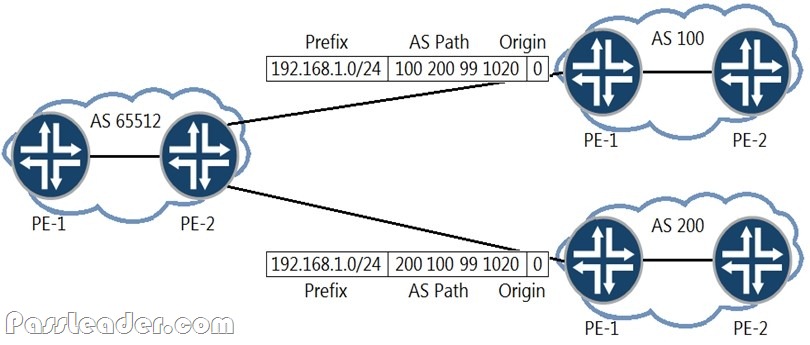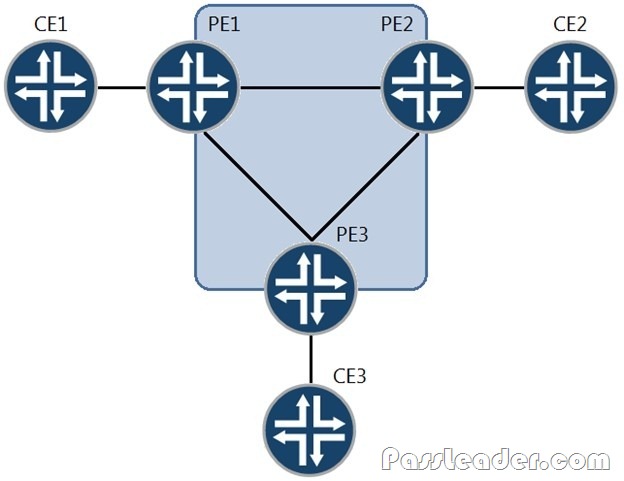The newest Juniper JN0-663 dumps are available from PassLeader, you can get both JN0-663 VCE dumps and JN0-663 PDF dumps from PassLeader! PassLeader have added the newest JN0-663 exam questions into its JN0-663 VCE and PDF dumps now, the new JN0-663 braindumps will help you 100% passing the JNCIP-SP JN0-663 exam. Welcome to download the valid PassLeader JN0-663 dumps VCE and PDF here: https://www.passleader.com/jn0-663.html (242 Q&As Dumps)
Besides, download that PassLeader JN0-663 braindumps from Google Drive: https://drive.google.com/drive/folders/1I0sqcCqEUuMy4wiZLNDKOYlGvjynmGgU (~More JN0-663 Exam Questions in PDF file~)
NEW QUESTION 226
You have a mixed vendor EVPN environment and you need to ensure VXLAN interoperability between all devices. In this scenario, which statement is correct?
A. You should only use Type 6 and Type 2 routes.
B. You should only use pure Type 2 routes.
C. You should only use Type 2 and Type 5 routes.
D. You should only use pure Type 5 routes.
Answer: C
NEW QUESTION 227
What is the purpose of the duster-list attribute within a BGP route reflector group?
A. to disable internal cluster re-advertisements
B. to define the router that first advertised the route to the route reflector
C. to override the router 10 value within the cluster
D. to facilitate loop detection within the route reflector network
Answer: D
NEW QUESTION 228
Which two statements about wide and narrow metrics used in IS-IS are correct? (Choose two.)
A. Wide metrics are sent by default and use 24 bits in TLVs to send information.
B. Narrow metrics are enabled by default and use 8 bits in TLVs to send information.
C. Disabling narrow metrics results in external routes being leaked from L1 to L2 areas automatically.
D. Wide metrics are enabled with the wide-metrics-or.ly parameter under protocols IS-IS hierarchy.
Answer: BC
NEW QUESTION 229
You are establishing a Layer 3 VPN between two PE devices Currently you have a single internal IPv4 BGP peering between the PE devices. You must ensure that the IPv4 and IPv6 routes from both CE devices are exchanged between these sites. Which two statements are correct in this scenario? (Choose two.)
A. You must establish an IPv6 BGP peering between the two PEs.
B. You must enable the inet-vpn NLR on both PE devices.
C. You must enable the inet6-vpn NLRI on both PE devices.
D. You must enable IPv6 tunneling on the LSPs between the PE devices.
Answer: BC
NEW QUESTION 230
Which two types of LSAs have an area scope? (Choose two.)
A. Type 5
B. Type 2
C. Type 7
D. Type 11
Answer: BD
NEW QUESTION 231
The link between CE1 and PE1 has a history of flapping To avoid the impact that flapping causes to the network you decide to use route damping. Which statement is correct in this scenario?
A. Dampened routes decay at a sliding rate known as half-life.
B. Routes become dampened when the configured max-suppress value is reached.
C. Dampening is enabled on interfaces.
D. Dampened routes become active when their figure of merit drops below the reuse value.
Answer: A
NEW QUESTION 232
Which two statements regarding Ethernet segments (ES) are correct? (Choose two.)
A. The Type-1 EVPN route will indicate if the ES is all-active or single-active.
B. The Type-4 EVPN route will be used to elect the designated forwarder for the ES.
C. The Type-2 EVPN route will indicate if there is a designated forwarder on the ES.
D. The Type-3 EVPN route will be used for the aliasing function to load-balance to the ES.
Answer: AC
NEW QUESTION 233
You are considering different MPLS VPN connectivity options of a new customer deployment. Your customer requires shared LSPs Layer 2 connectivity and auto-provisioning. Which type of VPN satisfies the requirements?
A. BGP Layer 3 VPNs
B. circuit cross-connects
C. BGP Layer 2 VPNs
D. LDP Layer 2 circuits
Answer: C
NEW QUESTION 234
You are deploying a new EVPN service for your customers. You must build the service based on the following requirements:
– both Layer 2 and Layer 3 functionality must be supported
– your customers must be able to support multiple VLANs in the same EVPN instance (EVI)
In this scenario which two types of routing instances should be configured? (Choose two.)
A. VRF
B. virtual switch
C. virtual router
D. EVPN
Answer: AD
NEW QUESTION 235
Which two statements are correct about Opaque LSAs in OSPF? (Choose two.)
A. Type 9 LSAs are used for graceful-restart and have link-local scope.
B. Type 11 LSAs are used for MPLS label exchange and have link-local scope.
C. Type 10 LSAs are used for MPLS traffic-engineering and have area scope.
D. Type 11 LSAs are used for MPLS traffic-engineering and have area scope.
Answer: AB
NEW QUESTION 236
Referring to the exhibit:

There is an Layer 3 VPN setup that connects sites CE-A-1, CE-A-2 and CE-A-3 together. Host-1 can communicate with Host-3, but Host-1 cannot communicate with Host-2. What must you do to solve the problem?
A. Use the auto-export command in both routing instances.
B. Change the route distinguisher in both routing instances to the same value.
C. Use the next-table configuration statement for static routes in the corresponding routing instances.
D. Use BGP instead of static routing between the CE and PE devices.
Answer: A
NEW QUESTION 237
Referring to the exhibit:

You are providing Carrier-of-Carrier VPN services for AS 100 and AS 200. You want to distribute MPLS labels between your PE routers and the AS 100 and AS 200 CE routers. What must be enabled to accomplish this task?
A. Use BGP with the labeled-unicast address family enabled.
B. Use RSVP with the tunnel-services parameter enabled.
C. Use BGP with the inet-vpn address family enabled.
D. Use RSVP with the lsp-set parameter enabled.
Answer: C
NEW QUESTION 238
Referring to the exhibit:

You are the administrator of AS 65512. You are learning the 192.168.1.0/24 prefix from both AS 100 and AS 200. You want traffic destined to the 192.168.1.0.0/24 prefix to exit your AS towards AS 200. How would you accomplish this task?
A. Configure an import routing policy on PE-2 to modify the origin attribute on the path learned from AS 100.
B. Configure an import routing policy on PE-2 to append the AS path attribute on the path learned from AS 100.
C. Configure an import routing policy on PE-2 to set a higher MED on the path learned from AS 100.
D. Configure an import routing policy on PE-2 to set a higher local preference value on the path learned from AS 200.
Answer: D
NEW QUESTION 239
Referring to the exhibit:

You are provisioning Layer 2 circuits between sites CE1, CE2, and CE3, which statement is true?
A. Two VLANs must be configured from PE1 to CE1.
B. A point-to-multipoint LSP must be created between sites.
C. Site PE1 must have a point-to-multipoint link configured towards the core.
D. Each site must have only one VLAN configured to the PE.
Answer: A
NEW QUESTION 240
Referring to the exhibit:

You have the LDP signaled VPLS topology as shown in the exhibit. CE-B at Site-2 is multihomed to both PE-2 and PE-3. In this scenario, where would you configure loop prevention?
A. PE-2
B. PE-3
C. CE-B
D. PE-1
Answer: D
NEW QUESTION 241
……
Thanks for reading the newest JN0-663 exam dumps! We recommend you to try the PREMIUM PassLeader JN0-663 dumps in VCE and PDF here: https://www.passleader.com/jn0-663.html (242 Q&As Dumps)
Also, you can download that PassLeader JN0-663 braindumps from Google Drive: https://drive.google.com/drive/folders/1I0sqcCqEUuMy4wiZLNDKOYlGvjynmGgU (~More JN0-663 Exam Questions in PDF file~)
